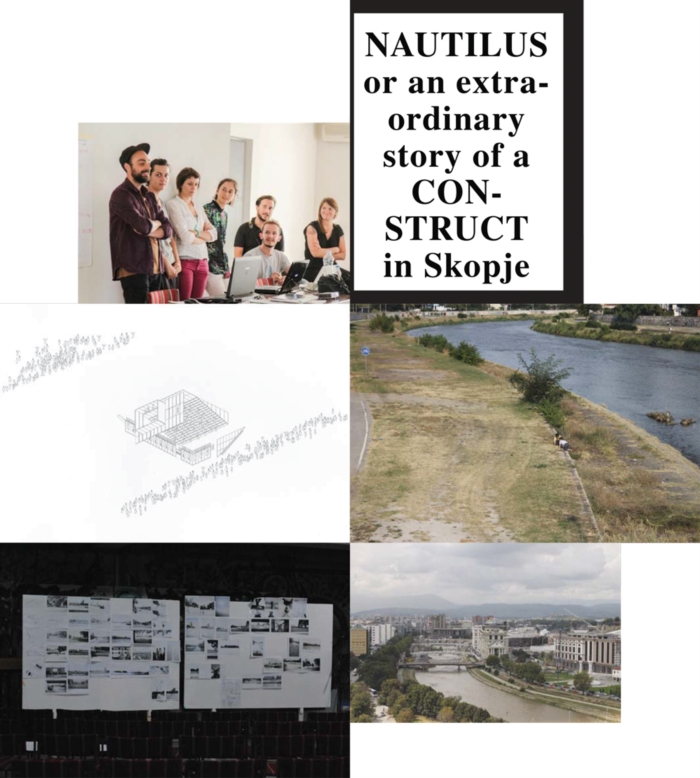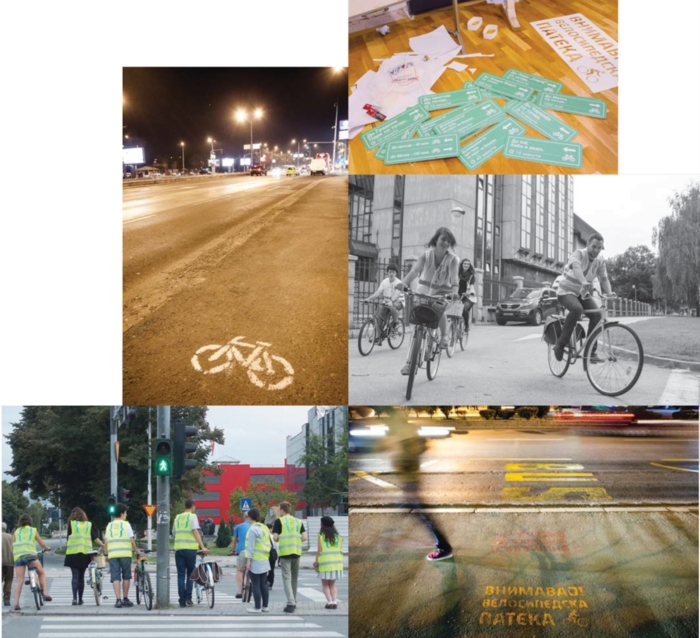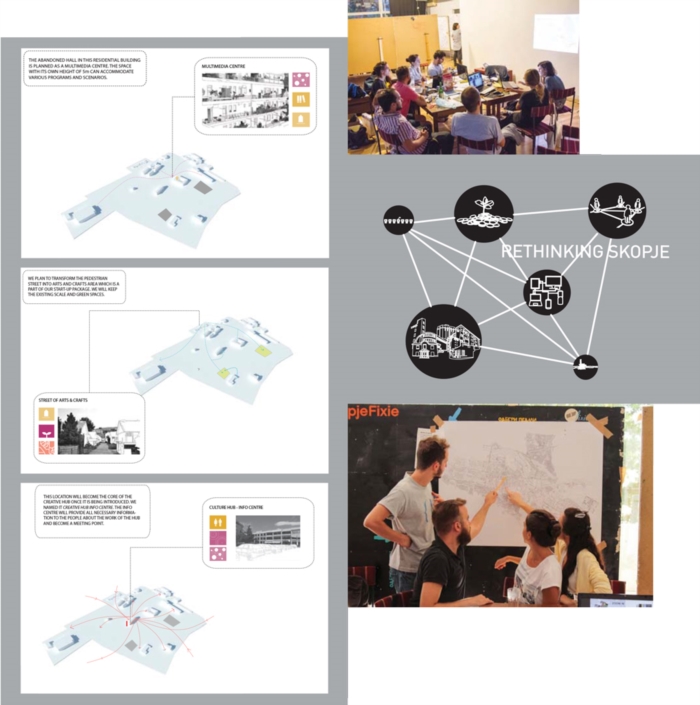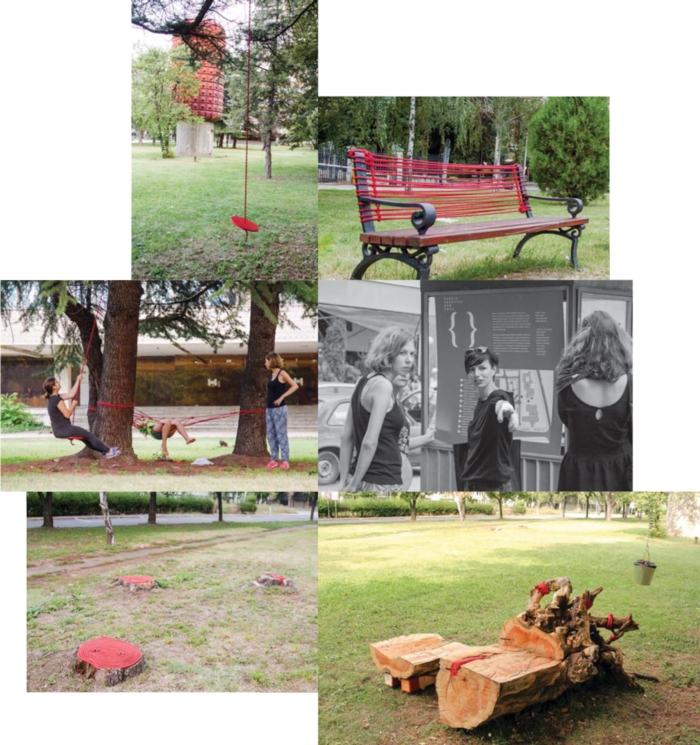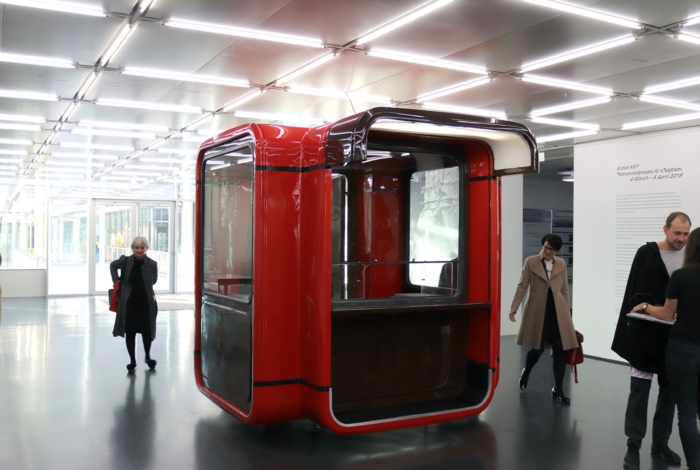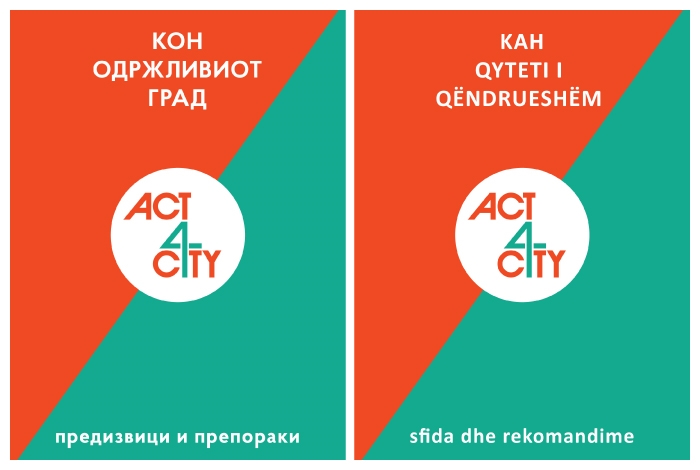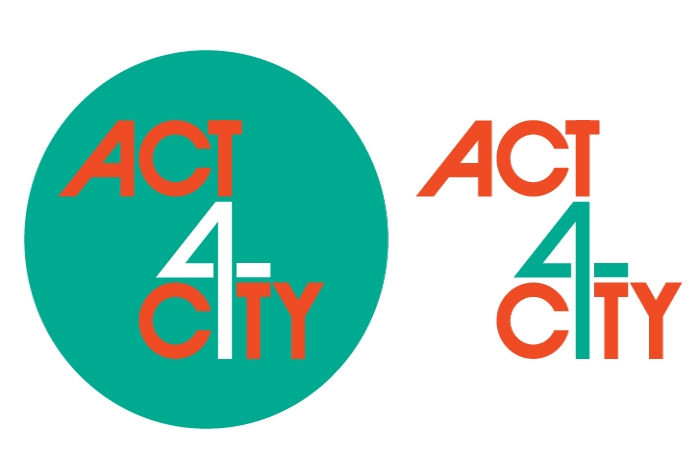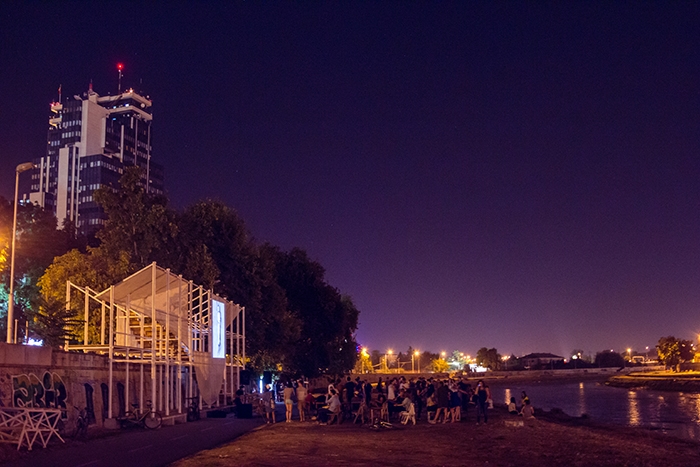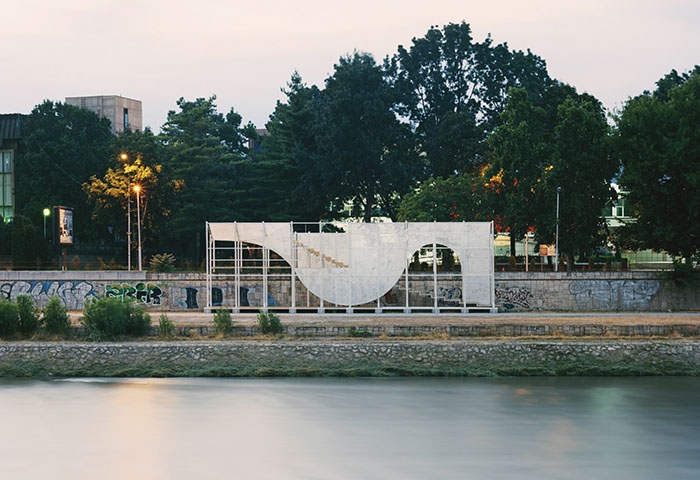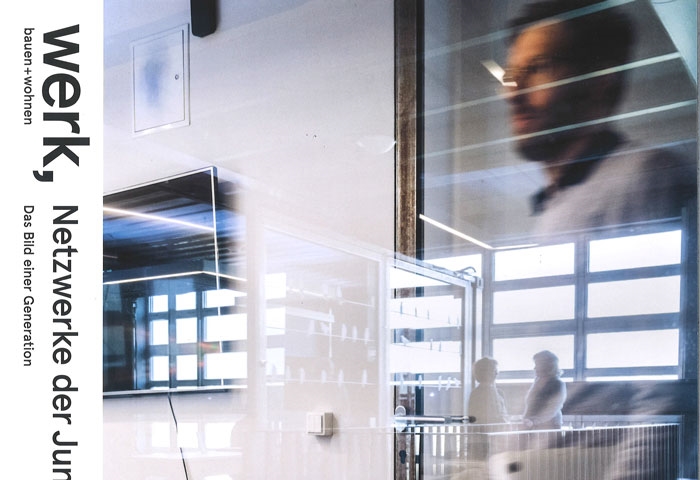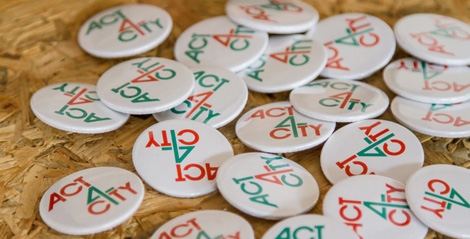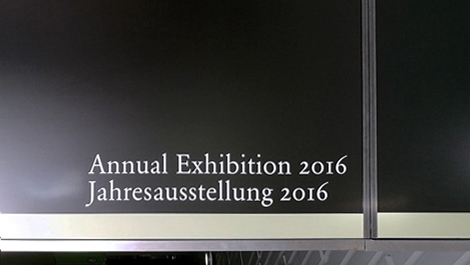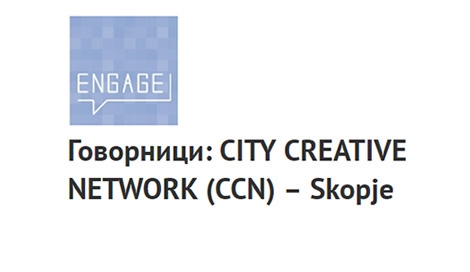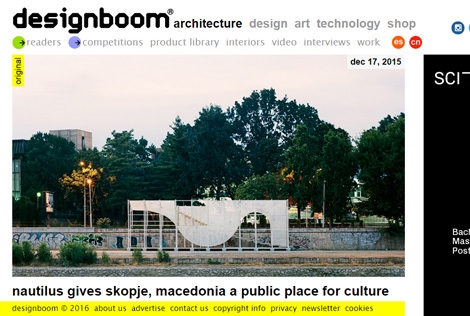CS: CONSTRUCTING A STAGE
BUU: BICYCLE URBANISM UNIT IN SKOPJE
RS: RETHINKING SKOPJE - IDENTIFYING URBAN TOOLS
PP: PUBLIC PLAYGROUNDS
Tutors: Ensamble (Zurich); RADiUs Architects (Skopje); Elena Dinovska (Skopje)
Participants: Darko Krstevski, Ivana Angelova, Marija Barović, Ines Galun, Simona Vidojevska, Mija Petreska
Why CS in Skopje?
A project for a new Public Stage in Skopje. A new Stage on the River, one to host theatre, music performances and public gatherings of any kind. A place for culture. A public stage as an opportunity to re-frame and imagine new possibilities of performances and enhance relations in-between Skopje’s epic and sometimes unusual ranges of public spaces and its inhabitants. The primary idea came from the local independent theatres (Wonderland and Theatra), who needed public space for performance and expression. The stage is a reaction to the lack of public space initiatives in Skopje and gives this group and others a stage where freedom of expression is imperative. The stage will be placed near the Youth Cultural Centre (MKC) and can be accessed 24h. The stage is a multifunctional, open-wooden structure, preferably mobile/modular and easily adaptable. It is in the centre of Skopje, but still in a very underdeveloped public area along the river embankments of Vardar. This area will soon experience major changes orchestrated by the city of Skopje aimed at becoming a new cultural area that connects the two riverbanks that will thereby strengthen the perimeter of the site for the stage and enhance this notion of a room on the water. A room to stay.
Why Ensamble, RADiUs Architects and Elena Dinovska?
This is a collaborative work of young architects, artists, builders and craftsmen. We approached Ensamble from Zürich, whose wooden pavilions have been awarded many times, to collaborate with the young and established RADiUs Architects and the stage designer Elena Dinovska from Skopje. Our main idea is to deepen the local and international exchange of creative expertise that will be centered around the building of the stage as a collaborative process. To work with Ensamble can be described as a privilege and possibility for collaborating on highest professional level.
Phases of realization
Phase 1: “Designing a Brief”; 29 August - 7 September 2014: Research on material and resources, local construction, craft and site survey
Phase 2: “Constructing a Stage”; Spring 2015: Building the stage and opening with a series of cultural events.
- BUU: BICYCLE URBANISM UNIT IN SKOPJE
Tutors: Florian Lorez, Smarter Than Car - STC (Vienna); NaTochak (Skopje)
Participants: Viktoria Paeva, Ani Arzumanyan, Zvonko Vugreshek, Ilina Cvetkova, Sandra Mojsova, Lazo Lazarov
Why BUU in Skopje?
Skopje has grown immensely in the last 10 years, boulevards were widened, green spaces diminished, number of cars doubled while decreasing space for pedestrians and cyclists. Booming Skopje has not yet considered an integral mobility strategy including all layers of society and celebrating active transport as potential for urbanization. This is the starting point for the Bicycle Urbanism Unit in Skopje. The Bicycle Urbanism Unit employs the humble bicycle to connect Skopje’s urbanization onto a human scale. The Bicycle Urbanism Unit works in performative ways, with subjective urban views, in cooperation with Skopje’s population and urban administrtion, with manual and digital tools. The Bicycle Urbanism Unit draws experiential maps of the city, reclaims public space currently occupied by the car and develops a bicycle urbanism vision for Skopje. We develop an alternative urban study for Skopje based on a non-motorized view of the city. The main outcome is a brochure with a strategic vision for the city titled: Skopje 2025 a Bicycle Friendly City, which was distributed to many members of the local authorities, decision makers, private developers and other interested parties in Skopje.
Why Florian Lorenz and NaTochak?
Florian Lorenz from the Beijing and Vienna based think-tank Smarter Than Car is working on strategies for developing ideas of Future Urban Mobility and Bicycle Urbanism on a global scale. His work ranges from activism to comprehensive urban mobility study for Beijing. We paired him with the local activist group NaTochak (OnBicycle) which together with the participants created the Bicycle Urbanism Unit in Skopje. NaTochak has been one of the most active NGO’s in Skopje, one that managed to built a strong community that is committed and active in promoting bicycle culture in the city. However, their work in raising the awareness about the use of the bicycle in Skopje is mainly activist and event oriented. Their collaboration with Florian Lorenz will elevate their work on a new, strategic level which includes activism and links it to comprehensive urban thinking together with the local authorities. This collaboration was beyond successful, and the group is still active today, months after the completion of the Skopje Creative Hub 2014.
- RS: RETHINKING SKOPJE: IDENTIFYING URBAN TOOLS
Tutors: Haris Piplas, Urban Think Tank - UTT (ETH, Zurich); Marko Icev (Skopje)
Participants: Jana Konstantinova, Martina Atanasovska, Ana Vehar, Marko Conevski, Iva Shokoska, Mirjana Lozanovska, Toni Popovski, Daniel Atanasovski
Why RS in Skopje?
The diversities in the city (social, ethnic, national, cultural) present great potentials for developing places of inclusion, coexistence and interaction. We combine qualitative and quantitative urban research methods on different scales in order to identify spatial potentials. We deploy various tools for research that range from analyses of statistical data and mapping spaces up to hands-on field research and interviews in close contact with citizens, NGOs, authorities and innovative star-tup companies. Once identified, the potentials are rethought and activated through strategic tools and scenario-based proposals. The material (graphic, textual, audio and video) feeds into an interactive-web-platform with shared database (SkopjeCreative.Net) that documents the research and activation process. The final outcome is a combined interactive web-platform where the results of this and the other groups are compiled and published in a digital database which becomes a platform for further collaborations. The central goal of our project is located in opening up the spaces for creative production, building a new community, bridging the divisions that exist in civil society and with it enhancing the quality-of-life aspects of Skopje. We think of Skopje as a city responsive to the needs of his inhabitants and a city that has a stable network of communication canals that enable higher levels of democracy in spatial governance and bottom-up planning processes.
Why Haris Piplas, Urban Think Tank (UTT) and Marko Icev?
The research topic of this group was framed by CCN, it is inspired by the work of UTT and based on both UTT and CCNs fields of interest. UTT from the viewpoint of an interdisciplinary design practice dedicated to high-level research and design on a variety of subjects, concerned with contemporary architecture and urbanism. CCN with its interest in activating public spaces through systematic and strategic change by project based collaborations and public debates. We combined our ways of thinking with the expertise of the architect and urban planner Marko Icev whose work and research focuses on issues of the urban context of Skopje. The experience of UTT as a global practice is embedded in the local context through the collaboration with Marko Icev.
Tutors: ProstoRož (Ljubljana); Ivana Kostovska (Skopje); Velimir Žernovski (Skopje/Belgrade)
Participants: Sonja Brdar, Nastasja Budjevac, Olga Srejić, Hilal Menlioglu, Damjan Balkoski, Marinela Arsovska, Gokhan Aydin, Ivona Krnjaić, Uroš Anzeljc
Why PP in Skopje?
The public playgrounds are urban installations which react to the lack of initiatives for activating open spaces in Skopje. They are based on personal interpretations of the public spaces around MKC - Youth Cultural Centre in Skopje. The installations are smart, small, highly visible and point out possible scenarios for alternative use of the public space. The public playgrounds are places that invite and provoke interaction. Through open access of public spaces to various social groups, we tried to understand the variety of uses of public spaces and answer the questions such as:
How to create places that invite and provoke curiosity for interaction?
How to raise awareness on the importance of public space and show its potentials?
How to test different solutions to issues in public space through short-term and temporary interventions?
The general idea of the interventions was to use the existing elements from the area and transforming them with minimal amount of materials and time. Once the installations were placed on site they received immediate and positive reaction from the citizens, while local media published an article about them.
Why ProstoRož, Ivana Kostovska and Velimir Žernovski?
Every project that ProstoRož develops is trying to raise the awareness of the meaning of public spaces and of building strong local communities that are capable of active involvement in managing their own environment. They do this by both small and large scale interventions and interactions with the citizens and the city officials. This approach is non-existent in Skopje and although there is a lot of buzz around the public spaces there is no real initiatives. We invited them in Skopje to test an approach inspired from their interaction with the city together with the local architect Ivana Kostovska and the renowned artist Velimir Žernovski that are both active and successful in the local context of Skopje.
* Excerpts from the BOOK SCH
Publisher: City Creative Network (CCN) Skopje
Editors-in-chief: Damjan Kokalevski and Milan Dinevski
Design: Neda Firfova
Proofreading: Marko Icev
Photographs: Ana Lazarevska
Print: Datapons; edition: 250; pages: 104
view BOOK SCH
download BOOK SCH


